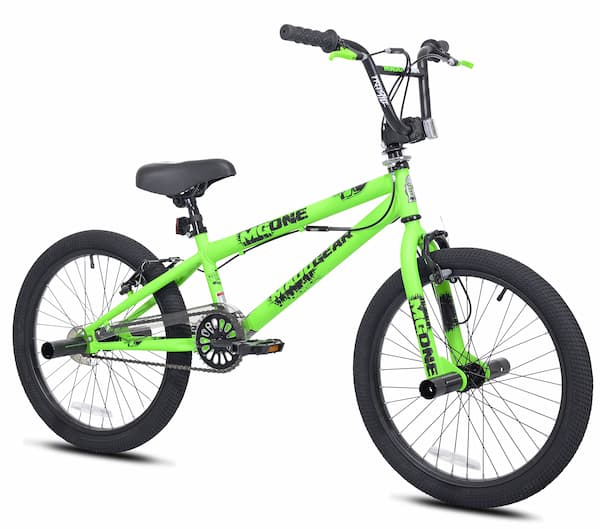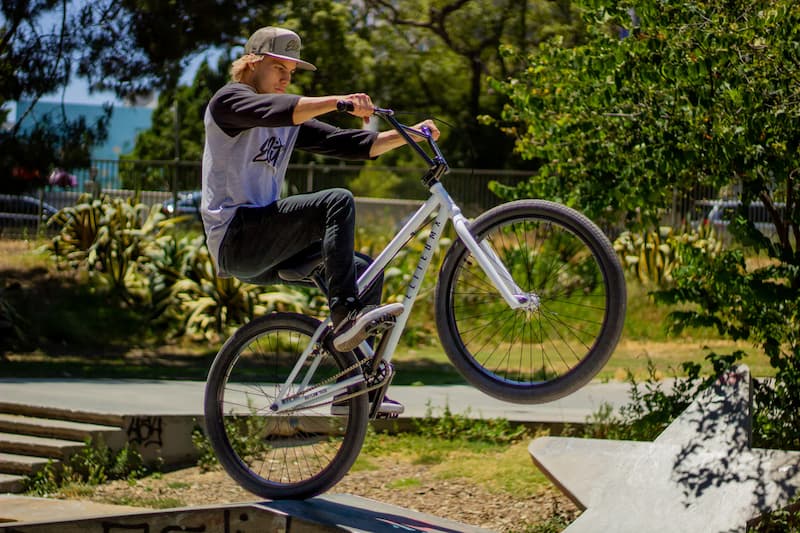BMX is one of the most well-liked kid’s bike categories. Although the term “BMX” is frequently used in a general sense, it’s crucial to realize that BMX bikes when you’re looking for one, so read on.
BMX stands for bicycle motocross. There are several distinct BMXing disciplines that are all practiced offroad in this heart-pounding cycling activity.
The smaller wheels and frames of BMX bikes help to identify them. In challenging riding environments like skate parks or pump tracks, their straightforward design makes them as simple to ride as possible.
Please read on.
Table of Contents
What is BMX?
It all began with real BMX bikes in the late 1960s. They were dirt track racers built to race over jumps and around berms that were modeled after motocross motorcycles. They were soon owned by kids everywhere, racers included. The light weight, speed, and dirt-worthiness of BMX bikes are still intended for racing, but your child need not race to enjoy them. In fact, a lot of kids primarily use theirs to get to and from school.
They usually have 20-inch wheels (24-inch-wheel “cruisers” are the exception), knobby tires, upright handlebars with crossbars, small saddles, long cranks and rear hand brakes. The bikes have strong, lightweight frames, and the more expensive they are, the lighter they are.
BMX bikes are typically made of durable chromoly steel or aluminum. Chromoly frames are slightly more expensive and heavier. Aluminum frames are made of oversized or unusually shaped tubing and are lighter. Aluminum is less heavy and also rustproof. There is no need to rush to touch up the frame if it gets scratched.
Different BMX Bike Types
Depending on their intended use, BMX bikes have evolved historically into a variety of different models. They fall into four categories, generally speaking.
Racing
For racing on a dirt track, the original BMX bike from the late 1960s to the early 1970s is ideal. In an effort to be the first to the finish line, BMX racers executed numerous jumps, berms, and turns.
It is an incredible demonstration of biking skills, navigating the course, and avoiding colliding with other riders.
To enable the rider to move quickly, BMX racing bikes are lightweight. The bicycle’s stability and maneuverability also enable the rider to maintain control over his ride without compromising speed or competitiveness.
The bikes have a low-profile, slender design that pairs with 20-inch wheels to balance speed and traction. The tall frame provides a clear line of sight and better handlebar control for the rider.
It has a longer crank, enabling the rider to maximize pedal power and increase effectiveness. Strong rear brakes provide excellent braking performance on the dirt track.
Freestyle
Freestyle BMX riders can ride their bikes almost anywhere. Their playground can be transformed into common streets and skate parks. The emphasis on airs and stunts rather than speed and jump handling distinguishes freestyle BMX bikes from other BMX bikes as the primary distinction.
Freestyle BMX bikes have front and rear wheel pegs for grinding, stalling, and standing tricks. A racing BMX bike’s frame weighs less than this one. Additionally, they have short gearing and a full brake setup.
- Street
By using street BMX bikes, regular city streets and alleyways are transformed into stunt arenas. Bikes perform a variety of tricks and stunts using stairs, walls, ledges, rails, and other urban features.
Speed and traction are guaranteed by the BMX bike’s smoother tires. For added impact resistance, the bike frame has additional reinforcement. Brakes on both the front and rear wheels are also essential.
- Vert
Vert BMX bikes are essentially street BMX bikes with a few adjustments for the rider’s preferences. To allow for maximum airiness while ensuring the bike won’t break in a hard landing, for instance, the bike frame must be strong yet lightweight.
In vert BMX biking, the objective is to ride from one halfpipe edge to the other, gain speed in the process, and then launch the bike into the air. The BMX vert rider performs various tricks in midair before repositioning his bike into the halfpipe.
- Park
Park BMX riders ride their bikes to a spot set aside for skateboarders and bikers that includes various concrete and wood features for tricks and stunts. For instance, many of these bike park courses include halfpipes, stairs, bowls, rails, quarter pipes, boxes, and ramps.
Thick frames are used on BMX bikes for park courses to increase impact resistance. Additionally, the bicycle has a small cassette and crank, two brakes, and smooth tires.
Dirt
Between racing and freestyle BMX bikes, dirt BMX bikes fill the void. The ride focuses on the quantity or height of jumps a BMX rider performs on a dirt track. This is why BMX organizations also refer to this particular form of riding as “BMX jumping.”
The bike can easily absorb hard landings and is lightweight and highly maneuverable.
Flatland
Instead of being competitive, this BMX biking style is more like a dance performance. Speed or maximizing air from each jump were not important to the rider. The number of tricks the rider can perform in a constrained area is what counts.
While maintaining an upright position for the bicycle, the rider can cross it by walking. Along the bike’s axis, he can make a variety of twists and spins, or he can wheelie the bike while it is stationary.
Compared to dirt, racing, and freestyle bikes, flatland BMX bikes are built differently. To ensure better clearance when performing tricks and stunts, it has a more compact and smaller frame.
The bike also has a freecoaster hub and a zero-offset fork, which enable the rider to spin the back wheel without cranking. The BMX biker can perform various stunts thanks to both features, which also help with balance.
The brake configurations, number of pegs, and crank arm length on these BMX bikes can also vary. The seatpost is long, and the tires are fully inflated.

Benefits of BMX Bikes
The advantages of BMX bikes are enormous. The main advantages of owning one include:
- Thrilling to ride on difficult terrain
- Great for children due to small bike stature
- Designed for maximum durability
- Small and light enough for easy transport
- Can be taken on some forms of public transport
Risks Associated With BMX Bikes
BMX bikes are not without risks and difficulties, despite their benefits.
BMX bikes can be used for quite dangerous stunts, which makes injuries more likely than with other types of bikes. Riders are at risk for severe injuries when they fall from high jumps on the typical courses.
Despite this, J Worrell’s publication from 1985 [5] compared accidents involving BMXs with those involving other types of bikes to determine whether the injuries sustained while BMXing were more severe.
The article notes that the test subjects who rode BMX bikes suffered injuries similar to those of those who rode other types of bikes. The article continues by pointing out that compared to road bike riders, BMX riders suffered from a lower percentage of serious injuries.
This is because road bikes are made to go much faster than BMXs. High speed collisions are more likely to be more serious.
The article comes to the conclusion that performing stunts on BMXs was the primary factor in accidents. The cause of these accidents, however, is poor cycling technique coupled with inexperience 50% of the time.
During racing competitions, it is also possible for competitors to collide at high speeds. Even with the right precautions, BMX sports can result in head injuries, bone fractures, or skin abrasions.
But hold on, the majority of the risks connected with riding a BMX can be reduced with enough practice.
Additionally, by donning the proper safety gear (gloves, body armor, a helmet, etc.) you’ll decrease the chance of getting hurt.
In conclusion, don’t let the risks deter you! Take things slowly, as you would with any new hobby.
Who Should Use a BMX Bike?
Due to the wide range of riding styles that BMX bikes offer, they are a popular option because they can accommodate different types of riders.
A BMX bike, also known as a bicycle motocross, is a bicycle made especially for performing jumps, tricks, and stunts. BMX bikes are less suitable for riding on roads, and depending on the preferred riding style, a designated area, such as a skate park or a pump track, is frequently required.
If you have experience with other extreme sports, it would be beneficial if you were thinking about taking up BMX.
The increased risk of injury when performing tricks and stunts on a BMX makes it the ideal vehicle for thrill-seekers and daredevils.
For shorter cyclists, a BMX’s smaller frame is very accommodating. Additionally, skate parks in urban settings are well-liked places for kids and teenagers to hang out, and given that a BMX bike fits this setting perfectly, skate parks are perfect for this age group.
Because of their chunky tyres, BMX bikes can be a great option for younger kids as long as they are closely supervised because they prevent them from gaining too much speed.
Who Shouldn’t Use a BMX Bike?
Not your typical cyclist should ride a BMX bike. Generally speaking, these bikes are not appropriate for riders who want nothing more than to cycle leisurely.
Long commutes on BMX bikes are not recommended due to the difficult and uncomfortable pedaling while seated. The majority of BMX bikes have a single-speed low gear, which significantly reduces the maximum speed that these bikes can travel at.
Older riders or those with pre-existing health or physical conditions should avoid BMX biking if they want to avoid injury because it is practiced in much more hazardous environments than other forms of biking.
How Different is BMX Bike Gears to Other Bicycle Types
It’s necessary to recognize how the BMX differs from other bicycle styles in order to fully grasp its meaning.
- First: The size of a BMX bike is necessary for riders to be able to pull off stunts and control the vehicle on bumpy dirt tracks.
- Second:In comparison to other bikes, the frame setup is also simpler. It is not necessary for a BMX bike to have an aerodynamic shape or a light frame. But compared to freestyle and stunt bikes, some racing BMX bikes tend to be made of lighter materials.
- Third:Fat, knurly, and thick describe BMX tires. To provide the best dirt track traction, they have deep treads. Additionally, the thick, fatty rubber acts as shock absorbers.
- Fourth:A BMX bike might not have a complicated braking system. On some models, especially children’s BMX bikes, a simple handbrake is sufficient.
- Lastly:There’s also the gearing on the bike. While other bike types will typically have multiple gears, the majority of BMX bikes only have one.
Riders of BMX bikes have two gear options: tall and short. The classification is based on the size of the sprocket; the taller the gear, the more teeth the sprocket has.
While flatland riders and some bikers favor short gear ratios because they are better suited for stalls and grinds on a vert or street course, racers frequently choose a BMX bike with tall gearing.
Does the BMX Bike Require a Special Area to Be Ridden?
In order to be ridden to their fullest potential, BMX bikes need special areas because they do not perform well on common bike paths and roads.
Skate parks and pump tracks are examples of these environments.
Concrete is typically used to construct skate parks, and with proper maintenance, they can last for a very long time.
Outside of urban areas, where long trials can be made for thrill seekers, BMX trailing or jump biking is typically practiced.
Cycling outdoors can enhance one’s appreciation of the natural world.
In the end, BMXs can be used anywhere. However, BMX riders can practice tricks and improve their riding skills on skate parks, pump tracks, and dirt trails.
Does a BMX Require Anything to Keep Functioning?
BMX bikes are made to last thanks to their durable, straightforward design. The majority of the time, they won’t require any complicated maintenance, but occasionally, parts will need to be changed.
Although these bikes have the potential to be damaged, the purpose of BMX is to perform daredevil tricks. To keep BMX bikes operating properly, maintenance and repairs must be made as needed.
Conclusion – What is a BMX Bike?
Just in case you forgot, a BMX bike, which stands for bicycle motocross, is a small bicycle intended for tricks and stunts.
Younger cyclists have always loved these bikes, which are frequently seen at skate parks.
I sincerely hope that the knowledge in this article was useful to you. If you notice anything that doesn’t look or sound right, please let me know in the comments section below. I’m always trying to improve the quality of the content I create.
Otherwise, drive safely and don’t forget to lock it or lose it!



